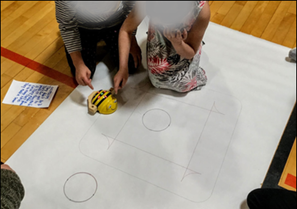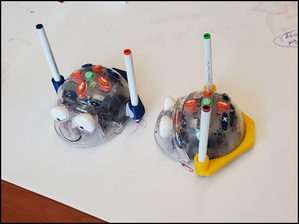First Graders Code Bee-Bots to Draw Shapes
Authors: Muteb Alqahtani and Jacob Hall
Article published in 2022 in Vol. 1 No. 2 of Journal of Technology-Integrated Lessons and Teaching
This story summarizes the original article, which you can click here to read in full.
In this innovative program, preservice teachers work with first-grade students in creating different geometric shapes. Students work collaboratively to program Bee-Bots to move on a specific path with two markers attached to the Bee-Bots to draw geometric shapes on a sheet of paper.
After exploring the robots, first-grade students are asked to create geometric shapes such as squares, rectangles, and circles. Students write and test their programs, observing the shape the robot drew for debugging.
Groups of 3–4 children completed four robotics activities, facilitated by elementary preservice teachers (PSTs). Each pair of PSTs worked with four first-grade students in the school’s gymnasium. The PSTs instructed the first-grade students to rotate through the four roles of programmer, input engineer, debugger, and recorder.
In this image, first-grade students collaboratively program a Bee-Bot.

After exploring with Bee-Bot to learn how to make it move and turn, students tested drawing on large sheets of paper taped to the floor.
Each group of students had a Bee-Bot outfitted with a 3D printed belt that positioned a pen on each side of the Bee-Bot and two markers. Links to the 3D print file and directions for its use are provided in the full article.
Students were first asked to draw a square of any size, and then a rectangle, recording their programs and observations on paper. They were asked how rectangles and squares are different and how they are similar, among other questions aimed to support their computation thinking skills.
The last task focused on creating circles. The students needed to figure out how to make Bee-Bot draw a circle. With the Bee-Bot’s unique pen configuration, the only solution was to have it turn repeatedly without moving forward. The students then engaged in a discussion about the similarities and differences among their programs to draw the various shapes.
This image shows Bee-Bots with a 3D printed attachment that holds two markers.

The activity detailed in this learning representation had a dual purpose:
- support first grade students’ mathematical and computational-thinking (CT) learning outcomes
- provide a robot-integrated, mathematics teaching experience for PSTs
The full article contains guidelines for introducing Bee-Bots to students, correlations with state and national math and technology learning standards, implementation strategies, learning objectives, evaluation and assessment criteria, and reflections on the project and planned extensions, use of the Bee-Bot and the 3D belt attachment with older students, and references to related research.
Read Dr. Hall’s other customer story about using Bee-Bots with Preschoolers.
Contact Information
| Name | Jacob A Hall, Ph.D. |
| Position | Associate Professor, Childhood/Early Childhood Education Department |
| School | State University of New York (SUNY), Cortland |
| Location | Cortland, NY |
| jacob.hall@cortland.edu | |
| Tags | Bee-Bot, Research, New York, Teacher Training, Math |
| Age | Grade 1 |
